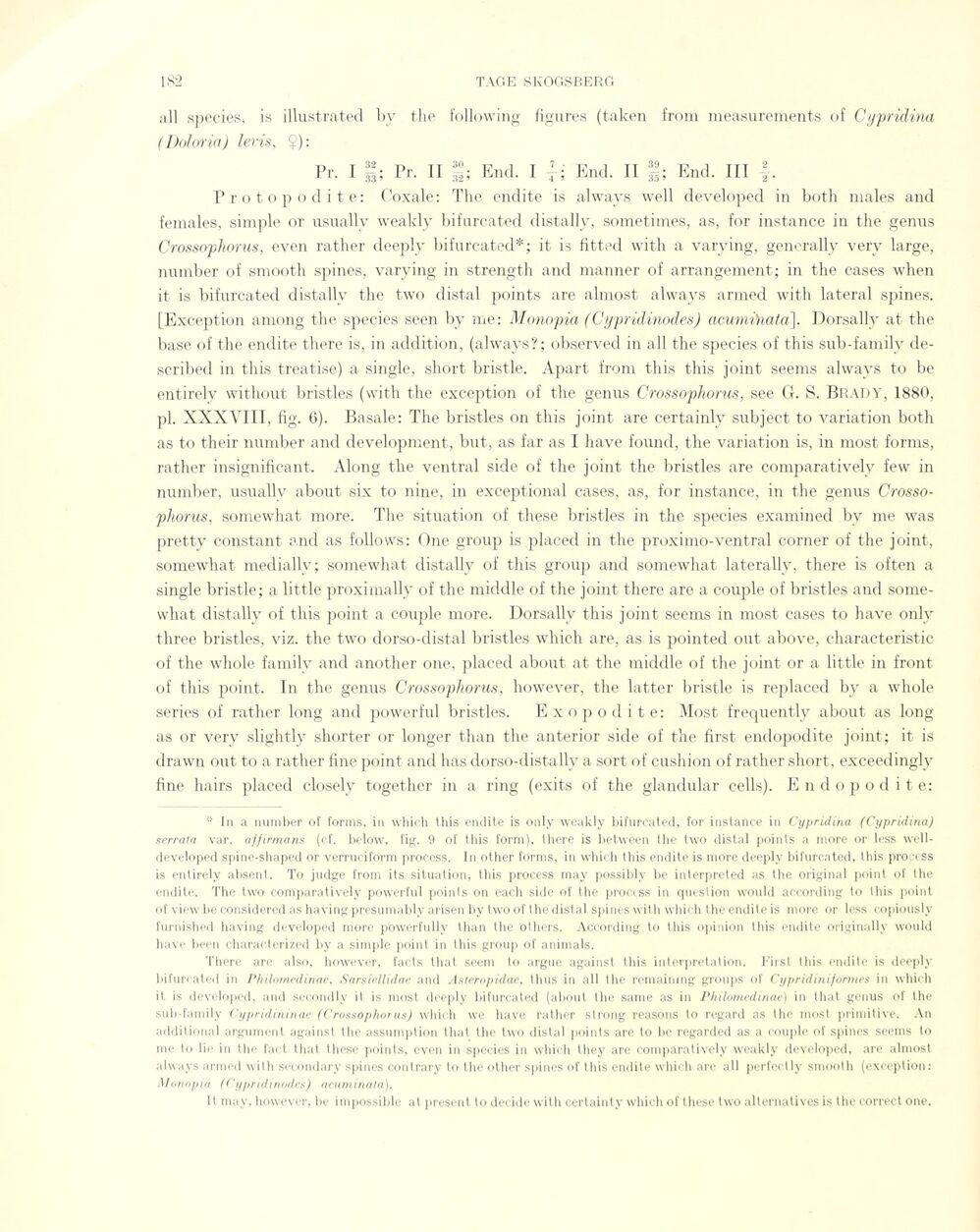
Full resolution (JPEG) - On this page / på denna sida - Sidor ...

<< prev. page << föreg. sida << >> nästa sida >> next page >>
Below is the raw OCR text
from the above scanned image.
Do you see an error? Proofread the page now!
Här nedan syns maskintolkade texten från faksimilbilden ovan.
Ser du något fel? Korrekturläs sidan nu!
This page has never been proofread. / Denna sida har aldrig korrekturlästs.
all species, is illustrated by the following figures (taken from measurements of Cypridina
(Doloria) levis, Ç) :
Pr. I |§; Pr. Il i; End. I
Ti End. Il 1;
End. III
Protopodite: Coxale: The endite is always well developed in both males and
females, simple or usuallv weakly bifurcated distally, sometimes, as, for instance in the genus
Crossophorus, even rather deeply bifurcated*; it is fitted with a varying, generally very large,
number of smooth spines, varying in strength and manner of arrangement; in the cases when
it is bifurcated distallv the two distal points are almost always armed with lateral spines.
[Exception among the species seen by me: Monopia (Cypridinodes) acuminata]. Dorsally at the
base of the endite there is, in addition, (always?; observed in all the species of this sub-family
de-scribed in this treatise) a single, short bristle. Apart from this this joint seems always to be
entirelv without bristles (with the exception of the genus Crossophorus, see G. S. BRADY, 1880,
pi. XXXVIII, fig. 6). Basale: The bristles on this joint are certainly subject to variation both
as to their number and development, but, as far as I have found, the variation is, in most forms,
rather insignificant. Along the ventral side of the joint the bristles are comparatively few in
number, usuallv about six to nine, in exceptional cases, as, for instance, in the genus
Crossophorus, somewhat more. The situation of these bristles in the species examined by me was
pretty constant and as foliows: One group is.placed in the proximo-ventral corner of the joint,
somewhat medially; somewhat distally of this group and somewhat laterally, there is often a
single bristle; a little proximally of the middle of the joint there are a couple of bristles and
somewhat distally of this point a couple more. Dorsally this joint seems in most cases to have only
three bristles, viz. the two dorso-distal bristles which are, as is pointed out above, characteristic
of the whole familv and another one, placed about at the middle of the joint or a little in front
of this point. In the genus Crossophorus, however, the latter bristle is replaced by a whole
series of rather long and powerful bristles. Exopodite: Most frequently about as long
as or very slightly shorter or longer than the anterior side of the first endopodite joint; it is
drawn out to a rather fine point and has dorso-distally a sort of cushion of rather short, exceedingly
fine hairs placed closely together in a ring (exits of the glandular cells). Endopodite:
- In a number of forms, in which this endite is only weakly bifurcated, for instance in Cypridina (Cypridina)
serrata var. affirmans (cf. below, fig. 9 of this form), there is between the tvvo distal points a more or less
well-developed spine-shaped or verruciform process. In other forms, in which this endite is more deeply bifurcated, this process
is entirely absent. To judge from its situation, this process may possibly be interpreted as the original point of the
endite. The two comparatively powerful points on each side of the process in question would according to this point
of view be considered as having presumably arisen by two of the distal spines with which the endite is more or less copiously
furnished having developed more powerfully than the others. According to this opinion this endite originally would
have been characterized by a simple point in this group of animais.
There are also, however, facts that seem to argue against this interpretation. First this endite is deeply
bifurcated in Philomedinae, Sarsiellidae and Asteropidae, thus in all the remairung groups of Cypridiniformes in which
it is developed, and secondly il is most deeply bifurcated (about the same as in Philomedinae) in that genus of the
sub-family Cypridininae (Crossophorus) which we have rather strong reasons to regard as the most primitive. An
additional argument against the assumption that the two distal points are to be regarded as a couple of spines seems to
me to lie in the faet that these points, even in species in which Utey are comparatively weakly developed, are almost
always armed with secondary spines contrary to the other spines of this endite which are all perfeetly smooth (exception:
Monopia (Cypridinodes) acuminata).
It may, however, be impossible at present to decide with certainty which of these two alternatives is the correct one.
<< prev. page << föreg. sida << >> nästa sida >> next page >>